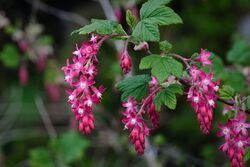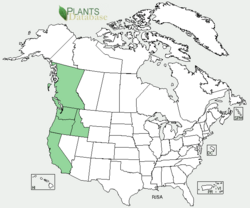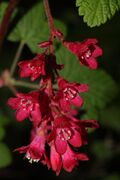Biology:Ribes sanguineum
| Ribes sanguineum | |
|---|---|

| |
| Scientific classification | |
| Kingdom: | Plantae |
| Clade: | Tracheophytes |
| Clade: | Angiosperms |
| Clade: | Eudicots |
| Order: | Saxifragales |
| Family: | Grossulariaceae |
| Genus: | Ribes |
| Species: | R. sanguineum
|
| Binomial name | |
| Ribes sanguineum Pursh 1813
| |

| |
| States and territories where it is native | |
| Synonyms[2] | |
| |
Ribes sanguineum, the flowering currant, redflower currant, red-flowering currant, or red currant[3] is a North American species of flowering plant in the family Grossulariaceae, native to the western United States and Canada.
Description
It is a deciduous shrub growing to 3 metres (10 feet) tall and broad.[4] It is naturally multi-stemmed with an upright-arching to rounded habit, although it can be grown in tree form.[5]
The bark is dark brownish-grey with prominent paler brown lenticels.
The leaves are of alternate arrangement, simple, 2–7 centimetres (1–3 inches) long and broad, palmately lobed with five lobes. When young in spring, they have a strong resinous scent.[5]
The flowers are produced in early spring at the same time as the leaves emerge, on dangling racemes 3–7 cm (1–3 in) long of 5–30 flowers; each flower is 5–10 millimetres (1⁄4–3⁄8 in) in diameter, with five red or pink petals.
The fruit is a dark purple oval berry about 1 cm (3⁄8 in) long, edible but with an insipid taste.[6]
Taxonomy
Varieties
| Image | Subspecies | Description | Distribution |
|---|---|---|---|
 |
Ribes sanguineum var. glutinosum | Racemes with 15–40 pendant flowers, sepals pink to white. | Oregon and California south to Santa Barbara County, and Guadalupe Island, elevations of 0–2,300 m (0–7,546 ft)[7] |
 |
Ribes sanguineum var. sanguineum[8] | Racemes with 5-15(-20) erect to stiffly spreading flowers, sepals red. | California, Idaho, Oregon, and Washington (state) , elevations of 1,300–2,400 m (4,300–7,900 ft).[9] |
Etymology
The Latin specific epithet sanguineum means 'blood-red'.[10]
Distribution
It is native to the western United States, Canada and Mexico. In western British Columbia,[11] Washington, and Oregon, it is distributed widely in the moist regions west of the Cascades.[12] In California it is restricted to areas near the coast, and can be found as far south as Santa Barbara County.[13] In Mexico, it is only found on the Pacific island of Guadalupe, where it may be extirpated.[14] Although its conservation status is secure across the rest of its range, in Idaho it is critically imperiled and is found only rarely in Bonner, Kootenai, Benewah, and Adams counties.[15][16]
It is widely cultivated and naturalized throughout temperate Europe and Australasia.[17]
Ecology
The early spring nectar of red-flowering currant is used by hummingbirds as well as butterflies, which along with moths browse the leaves in their larval stage. Deer and elk occasionally browse the leaves, and the berries are consumed by birds and small mammals. Its branches provide nesting habitat for birds.[18]
The species is a host to white pine blister rust, which led to eradication efforts in the early to mid 20th century. [3] From the 1920s the genus Ribes was federally restricted within the United States until the ban was lifted in 1966 due to increased resistance among both Ribes and Western white pine populations.[19]
Red-flowering currant is shade tolerant but prefers sunny sites. It tolerates drought well, but prefers cool and moist conditions.[4][19]
As an invasive species
Red-flowering currant has been an invasive species in New Zealand since it was naturalized in 1904,[20] where it forms dense stands in shrublands and along waterways which crowd out native vegetation.[21]
It is considered a 'significant environmental weed' in Tasmania, though only a minor problem as it is not widespread.[22]
Cultivation
R. sanguineum was introduced into cultivation in Britain in the fall of 1826 by Scottish botanist David Douglas, via seeds he had sent back during his explorations for the Royal Horticultural Society in the Pacific Northwest. It and its varieties and cultivars became immediately popular among English gardeners.[23] The noted botanist and RHS member John Lindley remarked:
-John Lindley, quoted in The Collector by Jack Nisbet [23]
It remains a popular garden shrub, valued for its brightly colored and scented flowers in early spring, and birds and habitat support. Numerous cultivars have been selected with flowers ranging from white to dark red. The following cultivars have gained the Royal Horticultural Society’s Award of Garden Merit:[24]
Uses
Both indigenous and non-indigenous people use the berries for food, eating them fresh or dried or making them into jams, pies, juice, or syrup.[18] The flowers can be used to infuse beverages, especially spirits.
References
- ↑ "Ribes sanguineum". NatureServe Explorer. NatureServe. https://explorer.natureserve.org/Taxon/ELEMENT_GLOBAL.2.159798/Ribes_sanguineum. Retrieved 2021-05-12.
- ↑ The Plant List, Ribes sanguineum Pursh
- ↑ Jump up to: 3.0 3.1 Fagan, Damian (2019). Wildflowers of Oregon: A Field Guide to Over 400 Wildflowers, Trees, and Shrubs of the Coast, Cascades, and High Desert. Guilford, CT: FalconGuides. pp. 201. ISBN 978-1-4930-3633-2. OCLC 1073035766. https://www.worldcat.org/oclc/1073035766.
- ↑ Jump up to: 4.0 4.1 "Red Flowering Currant | EMSWCD" (in en). 5 November 2013. https://emswcd.org/red-flowering-currant/.
- ↑ Jump up to: 5.0 5.1 "Ribes sanguineum | Landscape Plants | Oregon State University". https://landscapeplants.oregonstate.edu/plants/ribes-sanguineum.
- ↑ RHS A-Z encyclopedia of garden plants. United Kingdom: Dorling Kindersley. 2008. pp. 1136. ISBN 978-1405332965.
- ↑ "Ribes sanguineum var. glutinosum in Flora of North America @ efloras.org". http://www.efloras.org/florataxon.aspx?flora_id=1&taxon_id=250065816.
- ↑ "Ribes sanguineum". CalFlora. http://www.calflora.org/cgi-bin/species_query.cgi?where-calrecnum=7141. Retrieved 5 January 2010.
- ↑ "Ribes sanguineum var. sanguineum in Flora of North America @ efloras.org". http://www.efloras.org/florataxon.aspx?flora_id=1&taxon_id=250065815.
- ↑ Harrison, Lorraine (2012). RHS Latin for Gardeners. United Kingdom: Mitchell Beazley. ISBN 978-1845337315.
- ↑ Plants of British Columbia: Ribes sanguineum
- ↑ Turner Photographics, Ribes sanguineum - Wildflowers of the Pacific Northwest – includes photos, description, partial distribution map
- ↑ Calflora taxon report, University of California: Ribes sanguineum
- ↑ Rebman, Jon P.; Gibson, Judy; Rich, Karen (15 November 2016). "Annotated Checklist of the Vascular Plants of Baja California, Mexico". Proceedings of the San Diego Society of Natural History (San Diego Natural History Museum) 45: 178. http://sdplantatlas.org/pdffiles/BajaChecklist2016.pdf.
- ↑ "Red-flowered Currant (Ribes sanguineum) | Idaho Fish and Game". https://idfg.idaho.gov/species/taxa/60594.
- ↑ Biota of North America Program 2014 county distribution map
- ↑ Template:Grin
- ↑ Jump up to: 18.0 18.1 "Red-flowering Currant". https://www.fs.fed.us/wildflowers/plant-of-the-week/ribes_sanguineum.shtml.
- ↑ Jump up to: 19.0 19.1 "Ribes: Reintroducing a once common fruit genus". http://uncommonfruit.cias.wisc.edu/?p=316.
- ↑ "Ribes sanguineum" (in en). https://www.nzpcn.org.nz/flora/species/ribes-sanguineum/.
- ↑ "Weed Information Sheet" (in en). https://www.weedbusters.org.nz/what-are-weeds/weed-list/flowering-currant/.
- ↑ "National list of naturalised invasive and potentially invasive garden plants". 4 May 2006. https://invasives.org.au/wp-content/uploads/2018/02/WWF-National-list-of-naturalised-Invasive-garden-plants-2004.pdf.
- ↑ Jump up to: 23.0 23.1 Nisbet, Jack (2009). The Collector, David Douglas and the Natural History of the Pacific Northwest. Seattle: Sasquatch Books. pp. 183–184. ISBN 9781570616136.
- ↑ "AGM Plants - Ornamental". Royal Horticultural Society. July 2017. p. 87. https://www.rhs.org.uk/plants/pdfs/agm-lists/agm-ornamentals.pdf. Retrieved 9 October 2018.
- ↑ "RHS Plantfinder - Ribes sanguineum 'Koja'". https://www.rhs.org.uk/Plants/66407/i-Ribes-sanguineum-i-Koja/Details. Retrieved 9 October 2018.
- ↑ "'Poky's Pink'". RHS. https://www.rhs.org.uk/Plants/141438/Ribes-sanguineum-Poky-s-Pink/Details. Retrieved 19 March 2020.
- ↑ "RHS Plantfinder - Ribes sanguineum White Icicle = 'Ubric'". https://www.rhs.org.uk/Plants/44410/i-Ribes-sanguineum-i-Font-Face-times-New-Roman-White-Icicle-FONT-Ubric/Details. Retrieved 9 October 2018.
External links
- Jepson Flora Project: Ribes sanguineum
- Ribes sanguineum — Calphotos Photo gallery, University of California
Wikidata ☰ Q149372 entry
 |







